高考英语动词的时态和语态讲解
高考英语动词时态和语态考点精讲
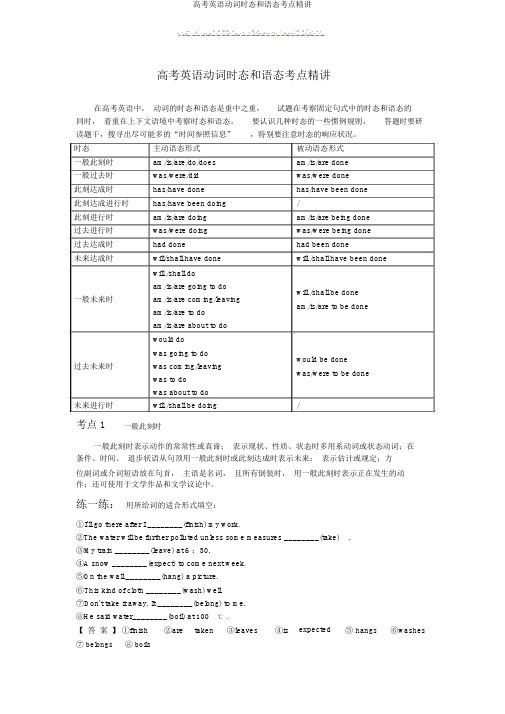
高考英语动词时态和语态考点精讲在高考英语中,动词的时态和语态是重中之重,试题在考察固定句式中的时态和语态的同时,着重在上下文语境中考察时态和语态。
要认识几种时态的一些惯例规则,答题时要研读题干,搜寻出尽可能多的“时间参照信息”,特别要注意时态的响应状况。
时态主动语态形式被动语态形式一般此刻时am/is/are/do/does am/is/are done一般过去时was/were/did was/were done此刻达成时has/have done has/have been done此刻达成进行时has/have been doing /此刻进行时am/is/are doing am/is/are being done过去进行时was/were doing was/were being done过去达成时had done had been done未来达成时will/shall have done will /shall have been donewill /shall doam/is/are going to dowill /shall be done一般未来时am/is/are coming/leavingam/is/are to be doneam/is/are to doam/is/are about to dowould dowas going to dowould be done过去未来时was coming/leavingwas/were to be donewas to dowas about to do未来进行时will /shall be doing /考点 1 一般此刻时一般此刻时表示动作的常常性或真谛;表示现状、性质、状态时多用系动词或状态动词;在条件、时间、退步状语从句顶用一般此刻时或此刻达成时表示未来;表示估计或规定;方位副词或介词短语放在句首,主语是名词,且所有倒装时,用一般此刻时表示正在发生的动作;还可使用于文学作品和文学议论中。
高考英语谓语动词的时态、被动语态和主谓一致
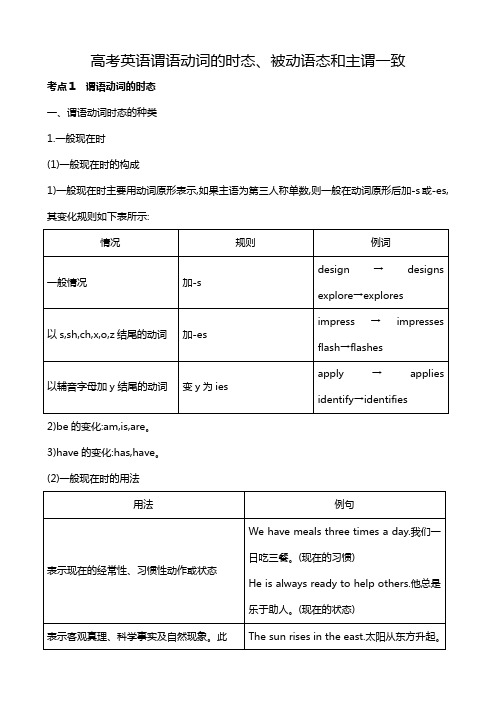
高考英语谓语动词的时态、被动语态和主谓一致考点1 谓语动词的时态一、谓语动词时态的种类1.一般现在时(1)一般现在时的构成1)一般现在时主要用动词原形表示,如果主语为第三人称单数,则一般在动词原形后加-s或-es,其变化规则如下表所示:2)be的变化:am,is,are。
3)have的变化:has,have。
(2)一般现在时的用法2.一般过去时(1)一般过去时的构成1)一般过去时用动词的过去式表示,其规则动词变化方法如下表所示:2)was用于第一、三人称单数,were用于其他情况。
3)注意以元音字母加y结尾的动词:规则变化是直接加-ed,如play→played;不规则变化是把y 改为id,如:pay→paid,say→said。
(2)一般过去时的用法3.一般将来时(1)一般将来时的构成(2)一般将来时的用法4.现在进行时(1)现在进行时的构成:is/am/are+现在分词(2)现在进行时的用法5.过去进行时(1)过去进行时的构成:was/were+现在分词(2)过去进行时的用法6.现在完成时(1)现在完成时的构成:has/have+过去分词(2)现在完成时的用法注意(1)瞬间动词若用于现在完成时且与表示一段时间的时间状语连用,需在谓语动词、时态或句型方面作相应变化。
如:他参军3年了。
(×)He has joined the army for 3 years.(√)He has been in the army for 3 years.(换动词)(√)He joined the army 3 years ago.(换时态)(√)It has been/is 3 years since he joined the army.(换句型)(2)部分瞬间动词(词组)与延续性动词(词组)对应表7.过去将来时(1)过去将来时的构成(2)过去将来时的用法8.将来进行时(1)将来进行时的构成:will/shall be doing(2)将来进行时的用法9.过去完成时(1)过去完成时的构成:had+过去分词(2)过去完成时的用法10.现在完成进行时(1)现在完成进行时的构成:have/has been doing(2)现在完成进行时的用法二、谓语动词时态的呼应1.主将从现2.含宾语从句的句子的时态一致问题(1)宾语从句中的动词时态常受主句谓语动词时态的制约,如果主句谓语动词为一般现在时或一般将来时,宾语从句中的谓语动词可以不受影响。
高中英语动词的时态和语态用法详解-文档.

给大家推荐一个英语微信群-Empty Your Cup
英语微信群是目前学习英语最有效的方法,群里都是说英语,没有半个中文,而且规则非常严格,是一个超级不错的英语学习环境,群里有好多英语超好的超牛逼的人,还有鬼佬和外国美眉。
其实坦白说,如果自己一个人学习英语太孤独,太寂寞,没有办法坚持,好几次都会半途而废。
只要你加入到那个群里以后,自己就会每天都能在群里坚持学,坚持不停地说和练,由于是付费群,群里的成员学习氛围非常强,每天的训练度都非常猛,本来很懒惰的你一下子就被感染了,不由自主地被带动起来参与操练,不好意思偷懒,别人的刻苦学习精神会不知不觉影响你,Empty Your Cup英语微信群(进群加喂新 601332975)可以彻底治好你的拖延症,里面学员都非常友好,总是给你不断的帮助和鼓励,让你在学英语的路上重新燃起了斗志,因为每天都在运用,你的英语口语就能得到了迅猛的提升,现在可以随便给一个话题,都能用英文滔滔不绝的发表5分钟以上对这个话题的看法和观点,想提高英语口语的 可以加入进来,It really works very well.。
2023年高考英语考前必练 谓语动词的时态语态(含近三年真题及解析)
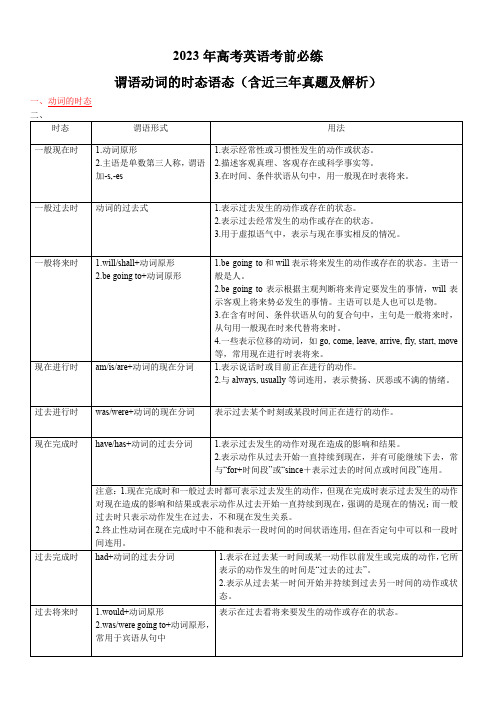
2023年高考英语考前必练谓语动词的时态语态(含近三年真题及解析)一、动词的时态特殊用法1.在时间、条件和让步状语从句中,如果主句谓语动词是一般将来时,从句用一般现在时。
如:We’ll have a picnic if it is fine next Sunday.如果下个星期日天气晴朗,我们将去野餐。
I’ll call you as soon as I get to Beijing tomorrow.我明天一到北京就给你打电话。
2.某些表示起始、往返、出发、到达之意的动词,可用一般现在时表示按规定、计划或安排将要发生的动作(此时一般都有一个表示未来时间的状语)。
这类动词有:begin, come, go, leave, start, arrive, end, stop, open, close等。
如:The meeting begins at 2:00 p.m. tomorrow.这个会议明天下午2点开始。
The next train leaves at 7 o’clock this evening.下一列火车将在今晚7点离开。
3.现在进行时与always, continually, forever等副词连用,表示反复出现或习惯性的动作,这种用法往往表达说话人的某种感情,如赞扬、遗憾、讨厌或不满等。
如:The rich woman is always laughing at the poor.这个有钱的夫人总是嘲笑穷人。
4.现在完成时中表示短暂动作的动词不能与for, since等引导的时间状语连用。
如与一段时间连用,要把瞬间动词转化为意思相近的延续性动词。
常见的变化有:特殊用法1.open,lock,write,read,sell,clean,wash,cut,drive等词作不及物动词时,它们的主语为物,可用主动语态表示被动意义。
如:This kind of pen writes very smoothly.这种钢笔写起来很流畅。
高中英语语法必备之谓语动词的时态和语态详解
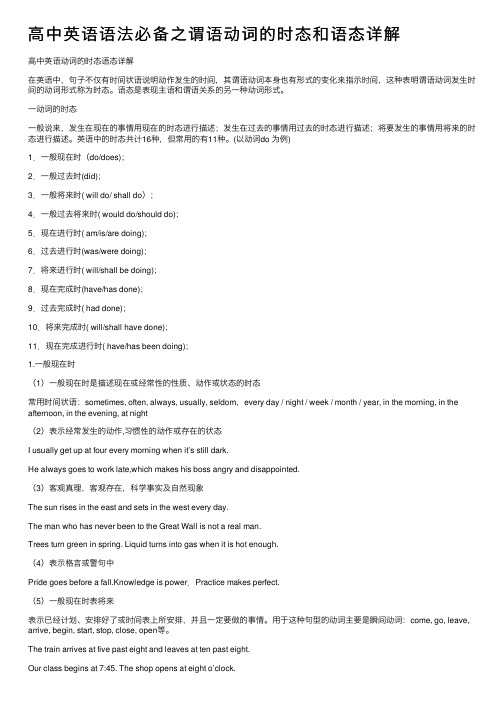
⾼中英语语法必备之谓语动词的时态和语态详解⾼中英语动词的时态语态详解在英语中,句⼦不仅有时间状语说明动作发⽣的时间,其谓语动词本⾝也有形式的变化来指⽰时间,这种表明谓语动词发⽣时间的动词形式称为时态。
语态是表现主语和谓语关系的另⼀种动词形式。
⼀动词的时态⼀般说来,发⽣在现在的事情⽤现在的时态进⾏描述;发⽣在过去的事情⽤过去的时态进⾏描述;将要发⽣的事情⽤将来的时态进⾏描述。
英语中的时态共计16种,但常⽤的有11种。
(以动词do 为例)1.⼀般现在时(do/does);2.⼀般过去时(did);3.⼀般将来时( will do/ shall do);4.⼀般过去将来时( would do/should do);5.现在进⾏时( am/is/are doing);6.过去进⾏时(was/were doing);7.将来进⾏时( will/shall be doing);8.现在完成时(have/has done);9.过去完成时( had done);10.将来完成时( will/shall have done);11.现在完成进⾏时( have/has been doing);1.⼀般现在时(1)⼀般现在时是描述现在或经常性的性质、动作或状态的时态常⽤时间状语:sometimes, often, always, usually, seldom,every day / night / week / month / year, in the morning, in the afternoon, in the evening, at night(2)表⽰经常发⽣的动作,习惯性的动作或存在的状态I usually get up at four every morning when it’s still dark.He always goes to work late,which makes his boss angry and disappointed.(3)客观真理,客观存在,科学事实及⾃然现象The sun rises in the east and sets in the west every day.The man who has never been to the Great Wall is not a real man.Trees turn green in spring. Liquid turns into gas when it is hot enough.(4)表⽰格⾔或警句中Pride goes before a fall.Knowledge is power.Practice makes perfect.(5)⼀般现在时表将来表⽰已经计划、安排好了或时间表上所安排,并且⼀定要做的事情。
完整版高考英语动词时态和语态讲解

时态语态〔一〕一般在表示:1.在的常性、性作 eg:IreadEnglisheverymorning.2.客真理、普遍公立、科学事eg:Thesunrisesintheeast.3.有的趣、好或能力eg:Helikesplayingfootball.4.存的性、特征或状eg:Thesituationisencouraging.5.介故事情、新eg:Workersfacetoughtimesabroad.6.按刻表或按定划、安排将要放生的作〔常如:come,go,leave,arrive,begin,start,takeoff,return,stop,open,close等〕eg:Thetrainleavesat4:30p.m.注意:here,there,now,then等开的倒装句要用一般在代替在行。
如:Look!Herecomesthebus.一般去表示:1.去常性、性的作或状eg:Heoftencriedwhenhewasaboy.2.去某的状或作eg:Iwenttothebankjustnow.3.用于Ididn’tknow⋯或Iforgot⋯,表示不知道或不得,但在道或得的事情。
eg:Ididn’tknowyouwerehere.Sorry,Iforgottobringmybook.注意:表示去常生的作,也可以用“usedtodo⋯〞和“woulddo〞一般将来表示: 1.在看来以后要生的作或存在的状eg:Tomwillcomenextweek.2.事物的固有属性或必然eg:Oilwillfloatinwater. Fishwilldiewithoutwater.3.将来某个作的安排、划eg:HeisgoingtospeakonTVthisevening.注意:将来常表达形式:will/shalldo;begoingtodo;betodo;beabouttodo 〔此形式不能与状用〕在行表示: 1.此此刻正在生的作eg:I’mstudyingEnglishnow.2.段正在生的作eg:Wearebuildingoursocialism.3.情况的性eg:Idon’treallyworkhere.Iamjusthelpinguntilthesecretaryarrives.4.与always,forever,constantly,continually 用,表示参上或等感情色彩,但并非作正在行eg:Heisalwayshelpingothers. Sheisalwaysforgettingsomething.5.按划、安排近期生的作〔只限于come,go,leave,arrive,start,move,sail,fly,travel,stay等〕eg:Aforeigneriscomingtovisitourschool. I’mleavingforBeijingtomorrow.注意:不宜用行的作:感:look,smell,feel,sound,taste,see,hear情感:like,love,prefer,admire, hate,fear 心:wish,hope,expect,want,need,believe,thin,understand,agree,know,remember,forget 所有:have,contain,won,hold,belongto去行表示: 1.去某一刻或段生的作eg:HewaswatchingTVthistimeyesterday.2.与always,forever,constantly,continually 用,表示或无等感情色彩eg:ComradeLei Fengwasalwaysthinkingofothersneverthinkingofhimself.3.去划、安排好的将来作〔只限于come,go,leave,arrive,start,move,sail,fly,travel,stay等〕eg:Hesaidhewasleavingthenextday. Iwastoldthetrainwasstartingsoon.注意:去行可用来描故事生的背景,如:Thewindwasblowinganditwasraininghard.去将来表示: 1.去某一刻后将要生的去作或去的意、打算〔主要用于从句中〕eg:She wassureshewouldsucceed. Ithoughtyouwouldcome.注意:把一般将来中的助成去式,便成了去将来的表达形式在完成表示: 1.在已完成或完成且在有影响的作eg:Ihavefinishedmyhomework.2.表示始于去持至今的作或状eg:He’slivedher esince2005. I’vetaughtEnglishfor15years.3.到目前止的一段内,多少次或第几次做某事eg:He’sbeentoBeijing severaltimes.It’sthethirdtimethatI’veseenthefilm.4.将来某将要做完的作〔限于和条件状从句〕eg:Don’tgetoffthebusuntilithas stopped.5.生在去的,但已成在的或eg:We’veallplayedwithsnowandice.注意:没有包括“在〞在内或不是截止到“在〞止的状不能与在完成用。
高中英语动词时态语态精讲及练习

高中英语动词时态语态精讲及练习一、时态(一)现在进行时用法注意点:1.状态性动词不用进行时态,包括(1)be和have,或者含有be 和have意义的动词,如:belong to, cont ain, depend on,等;(2)feel, sound, smell, taste等连系动词;(3)hear, see, find等表示结果的动词;(4)表示心理或情感状态的动词,如:believe, love, want, understan d, wish等;2.进行时态和副词always, forever等连用时,往往带有一定的感情色彩,如颂扬、批判、不满、埋怨等;eg. He is always criticizing us.(二)一样过去时与过去进行时的区别:1.过去进行时表示动作的未完成性、连续性,着眼于动作的过程;一样过去时表示动作的完成,即动作发生过,且已终止,着眼于结果;如:She was writing a report last night and I don’t know if she has fin ished it.(昨晚一直在写)She wrote a report last night.(表示昨晚写了,同时写好了)2.过去进行时与always, forever等词连用表示一定的感情色彩;He was always throwing things about. (表示不满或厌恶)(三)今后时的几种表达:还可用一样现在时、现在进行时表示今后发生的动作;(四)今后进行时与今后完成时:1.今后进行时表示今后某一时刻发生的动作,结构为:will / shall be doing2.今后完成时表示到今后某时刻某动作已发生,结构为:will / shall h ave done,时刻状语为:by+表今后时刻的词语;如:I’ll be climbing the mountain this time the day after tomorrow.By the time he graduates from the college, he will have learned thre e foreign languages.(五)现在完成时及过去完成时的用法注意点:1.瞬时性动词与连续性动词的正确使用:与how long, for, since等表示一段时刻的状语连用时须用连续性动词,如:die-be dead, marry-be ma rried, begin-be on, begin to know-know等;2.注意have been to与have gone to的区别;4.by+过去时刻状语用过去完成时;5.有些动词的过去完成时表示过去未曾实现的意图、打算或期望,这类动词为:think, plan, mean, intend, hope, expect, suppose等;I had intended to visit you yesterday, but the rain prevented me.(六)现在/过去完成进行时的用法:强调动作连续到说话时且还在进行;结构:have (has) / had been doing比较:They have repaired the road.(表示路已修好)They have been repairing the road. (表示路还在修)有时两者可替换:She has taught in this middle school for ten years.She has been teaching in this sch ool for ten years.注意:完成进行时不可与瞬时性动词连用,如:finish, go, marry等;(七)某些固定句型中时态是固定的:1.This / That / It is the first time +从句(用现在完成时)2.It’s / has been +一段时刻+since从句(用过去时)3.It will be +一段时刻+before从句(用一样现在时)/ It was +一段时刻+before从句(用过去时)4. It’s time+从句(用过去时或should do)5.would rather+从句(用一样过去时/过去完成时)It’s getting late. I’d rather you took a taxi there.The film was boring. I’d rather I hadn’t gone to see it.二、语态语态概述英语的语态是通过动词形式的变化表现出来的。
高考英语动词的时态和语态语法知识点与技巧方法
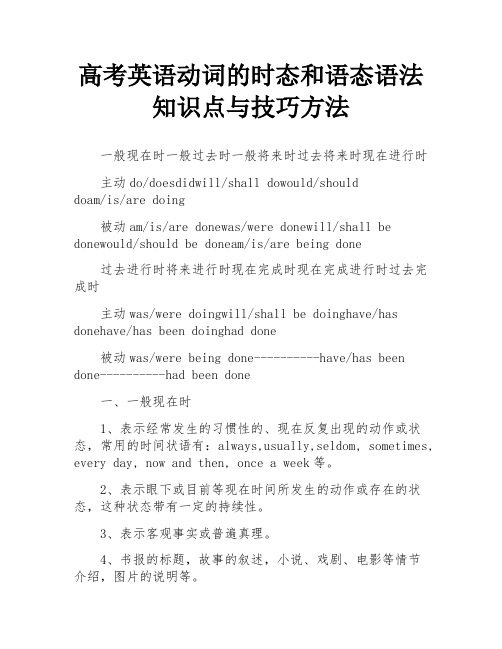
高考英语动词的时态和语态语法知识点与技巧方法一般现在时一般过去时一般将来时过去将来时现在进行时主动do/doesdidwill/shall dowould/shoulddoam/is/are doing被动am/is/are donewas/were donewill/shall be donewould/should be doneam/is/are being done过去进行时将来进行时现在完成时现在完成进行时过去完成时主动was/were doingwill/shall be doinghave/has donehave/has been doinghad done被动was/were being done----------have/has been done----------had been done一、一般现在时1、表示经常发生的习惯性的、现在反复出现的动作或状态,常用的时间状语有:always,usually,seldom, sometimes, every day, now and then, once a week等。
2、表示眼下或目前等现在时间所发生的动作或存在的状态,这种状态带有一定的持续性。
3、表示客观事实或普遍真理。
4、书报的标题,故事的叙述,小说、戏剧、电影等情节介绍,图片的说明等。
5、时间表、时刻表、日程表、节目单、课程表等按规定将要发生的动作,只限于go, arrive, leave, start, stay, return, begin, e等动词。
6、在时间、条件、方式、让步状语从句中,表示将来的动作。
注意:一般现在时可以用于定语从句或宾语从句中表示将来。
7、用在某些表达中,表示现在正在发生的动作或存在的状态。
Here es the bus!How it rains!二、一般过去时1、表示在过去某一时间点发生的动作或所处的状态,与现在没有关系。
常用的时间状语有:yesterday, last night, at that time等。
动词的时态和语态讲解

一、动词的时态和语态(一)动词的时态。
英语动词有16种时态,但是常用的只有9种:一般现在时、一般过去时、一般将来时、现在进行时、过去进行时、现在完成时、过去完成时、过去将来时、现在完成进行时。
下面分别介绍。
1、一般现在时的用法。
1)表示经常性、习惯性的动作;表示现在的状态、特征和真理。
句中常用often, usually, every day 等时间状语。
例如:a. He goes to school every day.b. He is very happy.c.The earth moves around the sun.2) 在时间状语从句和条件状语从句中,用一般现在时表示将来。
例如:a. If you come this afternoon, we’ll have a meeting.b. When I graduate, I’ll go to countryside.3) 有时这个时态表示按计划、规定要发生的动作(句中都带有时间状语),但限于少数动词,如:begin, come, leave, go ,arrive, start , stop, return, open, close 等。
例如:a. The meeting begins at seven.b. The rain starts at nine in the morning.4) 表示状态和感觉的动词(be, like, hate, think, remember, find, sound 等)常用一般现在时。
a. I like English very much.b. The story sounds very interesting.5) 书报的标题、小说等情节介绍常用一般现在时。
2.一般过去时的用法。
1)表示过去某时间发生的事、存在的状态或过反复发生的动作。
a. He saw Mr. Wang yesterday.b. He worked in a factory in 1986.2)表示过去经常发生的动作,也可用“used to “ 和“would + 动词原形”。
高中英语动词的时态和语态

高中英语动词的时态和语态高中英语动词的时态和语态一、动词的时态时态是谓语动词所表示的动作或情况发生时间的各种形式。
常用的有9种,即一般现在时、一般过去时、一般将来时、现在进行时、过去进行时、现在完成时、过去完成时、过去将来时、现在完成进行时(其他比较常用的还有将来进行时、将来完成时)。
(一)一般现在时I、构成:肯定式:1) ( I )+ am / do2)(单数名词、不可数名词、动词不定式和其短语、动名词及其短语、从句、HIt )+ is/does3) (复数名词、We, You, They) + are /do否定式:1) ( I ) am not / don’t do2) (单数名词、不可数名词、动词不定式和其短语、动名词及其短语、从句、HIt )is not /doesn’t do3) (复数名词、We, You, They) are not /don’t do 疑问式:1) am ( I ) / do ( I ) do …?2) is(单数名词、不可数名词、动词不定式和其短语、动名词及其短语、从句、HIt )…+?3) does(单数名词、不可数名词、动词不定式和其短语、动名词及其短语、从句、HIt )+ do…+?4) are (复数名词、We, You, They) …?5) do (复数名词、We, You, They) do … ?II、用法:1、表示经常性、习惯生的动作;表示现在的状态、特征和真理。
句中常用often, usually, every + 时间名词等时间状语。
如:1)地球绕着太阳转。
The earth moves around the sun. (真理)2)我们非常高兴。
We are very happy. (现在的状态)3)他每天坚持做早锻炼。
Haking morning exvery day.(经常性的动作)2、在时间状语从句和条件状语从句中,用一般现在时表示将来。
高考英语动词时态和语态

高考英语动词时态和语态I.要点1、一般现在时(1)表示经常发生的动作或现在存在的状态,常与sometimes, always, often, every day 等时间状语连用。
如:Sometimes, we go swimming after school.(2)表示客观真理、科学事实等。
如:The earth goes round the sun.2、现在进行时(1) 表示说话时或现阶段正在进行的动作,常与now, at present等时间状语连用。
如:What are you doing now?(2) 和always, continually等连用,表一种经常反复的动作,常含有某种情感。
如:He is always doing good deeds.3、现在完成时主要表示动作发生在过去,对现在仍有影响,或动作一直延续到现在,或可能还要继续下去,常与just, already, so far, once, never 等词连用。
如:Have you ever been to Beijing?4、一般将来时表示将来某一时间要发生的动作或存在的状态,常与tomorrow, next year等连用。
如:I'll meet you at the school gate tomorrow morning.We're going to see a film next Monday.5、一般过去时表示在过去某一时间或某一阶段内发生的动作或存在的状态,常与yesterday, last year, in1998, a moment ago等词连用。
如:It happened many years ago.6、过去进行时表示过去某一时刻或某一时期正在发生的动作。
如:What were you doing this time yesterday?7、过去完成时表示在过去某一时间或动作之前已经发生或完成了的动作。
高考英语时态和语态详解

高考英语时态和语态详解动词的时态和语态一、时态1、一般现在时(do/does; is/am/are)①表示现在的情况、状态或特征。
例:He is a student.他是一个学生。
②表示经常性、习惯性动作。
例:He always helps others.他总是帮助别人。
③客观事实和普遍真理。
例:The earth moves the sun.地球绕着太阳转。
④表示一个按规定、计划或安排要发生的动作。
仅限于某些表示“来、去、动、停、开始、结束、继续”等的动词,可以与表示未来时间的状语搭配使用。
常见的用法是:飞机、火车、轮船、汽车等定期定点运行的交通方式。
例:The next train leaves at 3 o'clock this afternoon.下一趟火车今天下午3点开车。
⑤在时间、条件和让步状语从句中经常用一般现在(有时也用现在完成时)表示将的来事情。
(即:主将从现原则)例:I will call you as soon as I arrive at the airport.我一到机场就会给你打电话。
When you have finished the report, I will have waited for about 3 hours.等你完成这份报告的时候,我就已经等了将近3个小时了。
2、现在进行时(am/is/are doing)①表示此时此刻正在发生的事情。
例:He is listning to the music now.他现在正在听音乐。
②表示目前一段时间内一直在做的事情,但不一定此时此刻正在做。
例:I am studying computer this term.这个学期我一直在学习计算机。
③现在进行时可以表示将来的含义。
瞬时动词的进行一定表将来。
例:I am leaving.我要离开了。
持续动词的进行只有有将来的时间状语或有将来语境中才表将来。
例:I am travelling next month.下个月我要去旅行。
高考英语语法之动词的时态和语态(有解析)
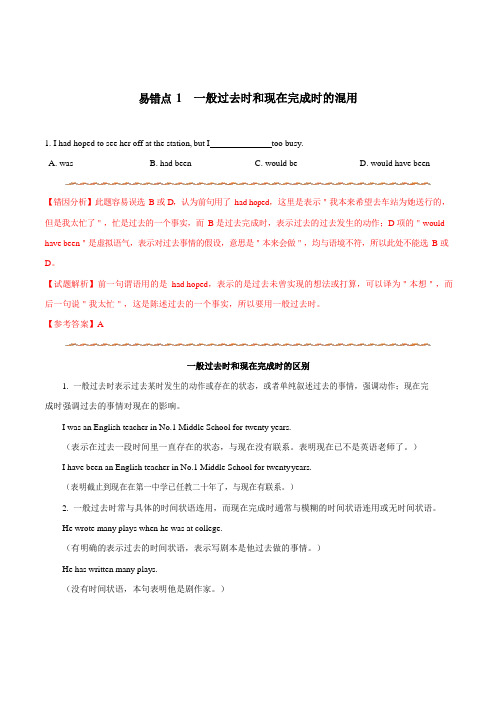
易错点1 一般过去时和现在完成时的混用1.I had hoped to see her off at the station, but I too busy.A. wasB. had beenC. would beD. would have been【错因分析】此题容易误选B 或D,认为前句用了had hoped,这里是表示"我本来希望去车站为她送行的,但是我太忙了",忙是过去的一个事实,而B 是过去完成时,表示过去的过去发生的动作;D 项的"would have been"是虚拟语气,表示对过去事情的假设,意思是"本来会做",均与语境不符,所以此处不能选B 或D。
【试题解析】前一句谓语用的是had hoped,表示的是过去未曾实现的想法或打算,可以译为"本想",而后一句说"我太忙",这是陈述过去的一个事实,所以要用一般过去时。
【参考答案】A一般过去时和现在完成时的区别1.一般过去时表示过去某时发生的动作或存在的状态,或者单纯叙述过去的事情,强调动作;现在完成时强调过去的事情对现在的影响。
I was an English teacher in No.1 Middle School for twenty years.(表示在过去一段时间里一直存在的状态,与现在没有联系。
表明现在已不是英语老师了。
)I have been an English teacher in No.1 Middle School for twenty years.(表明截止到现在在第一中学已任教二十年了,与现在有联系。
)2.一般过去时常与具体的时间状语连用,而现在完成时通常与模糊的时间状语连用或无时间状语。
He wrote many plays when he was at college.(有明确的表示过去的时间状语,表示写剧本是他过去做的事情。
)He has written many plays.(没有时间状语,本句表明他是剧作家。
高考英语真题分项详解 动词的时态语态和主谓一致
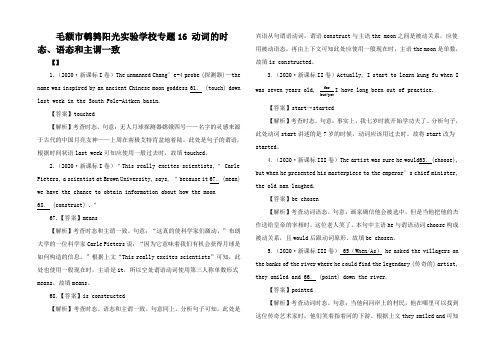
毛额市鹌鹑阳光实验学校专题16 动词的时态、语态和主谓一致【】1.(2020·新课标I卷)The unmanned Chang’e-4 probe (探测器)—the name was inspired by an ancient Chinese moon goddess 61. (touch) down last week in the South Pole-Aitken basin.【答案】touched【解析】考查时态。
句意:无人月球探测器嫦娥四号——名字的灵感来源于古代的中国月亮女神——上周在南极艾特肯盆地着陆。
此处是句子的谓语,根据时间状语last week可知应使用一般过去时,故填touched。
2.(2020·新课标I卷)"This really excites scientists," Carle Pieters, a scientist at Brown University, says, "because it 67. (mean) we have the chance to obtain information about how the moon68. (construct) ."67.【答案】means【解析】考查时态和主谓一致。
句意:“这真的使科学家们激动,”布朗大学的一位科学家Carle Pieters说:“因为它意味着我们有机会获得月球是如何构造的信息。
”根据上文“This really excites scientists”可知,此处也使用一般现在时,主语是it,所以空处谓语动词使用第三人称单数形式means,故填means。
68.【答案】is constructed【解析】考查时态、语态和主谓一致。
句意同上。
分析句子可知,此处是宾语从句谓语动词,谓语construct与主语the moon之间是被动关系,应使用被动语态,再由上下文可知此处应使用一般现在时,主语the moon是单数,故填is constructed。
2024年新高考版英语专题七谓语动词的时态和被动语态 讲解部分

3)表示客观事实、普遍真理或格言等。 例句 Light travels faster than sound. 光比声音传播得快。 Magellan proved that the earth is round. 麦哲伦证实地球是圆的。 4)表示将来。 ①在时间状语从句、条件状语从句或让步状语从句中。 例句 Even if we achieve great success in our studies, we will not be conceited. 即使我们在学习上取得很大成功,我们也不会自大的。(让步状语从句)
温馨提示 常与一般现在时连用的状语有often, always, usually, sometimes, every day, occasionally, never, seldom, generally, rarely, once a week, at weekends, on Sundays等。 2)表示现在的特征、能力、性格等。 例句 This job calls for great patience. 这份工作需要极大的耐心。 We are very busy these days. 这些天我们很忙。
2)be doing可用来表示计划、安排好要采取的动作或要做的事情,常与表 将来的时间状语连用。 例句 We're leaving early tomorrow morning. 我们明天一早就出发。 3)一般现在时可以表示按规定、计划或时间表要发生的事;在条件、时 间、让步状语从句中可用一般现在时表将来。 例句 According to the timetable, we have no classes tomorrow. 根据时间安排,明天我们不上课。 I'll write to her when I have time. 我有空会给她写信。
高三英语高考语法知识点归纳总结动词的时态和语态
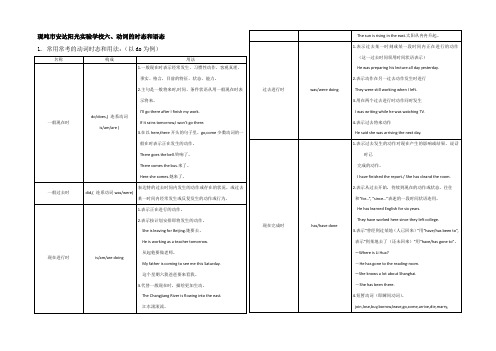
I read the novel last month. (只说明上个月看了,不涉及现在是否记住)
现在完成时与现在完成进行时的比较
着重表示动作的结果时,用现在完成时
I have read that book.我读过那本书了。(知道那本书的内容)
着重表示动作一直在进行,即动作的延续性时,则用现在完成进行时
(只说明他过去当过木匠不涉及到现在)
一般过去时只表达过去的动作或状态
Hello, I ____ you were in London. How long _________ here?
A. don’t know; were you B. hadn’t known; are you
C. haven’t known; areD. didn’t know; have you been
—Hi, Tracy, you look tired.
—I am tired. I _______ the living room all day.
A. paintedB. had painted
C. have been paintingD. have painted
说明:强调动作从过去到现在的延续
— Oh, I’m terribly sorry. _______.
A. I’m not noticing.B. I wasn’t noticing.
C. I haven’t noticed.D. I don’t notice.
说明:对话的后者显然是在解释刚才不小心冒犯对方时正在做的事情.
一般过去时与过去进行时的比较
Here she comes.她来了。
一般过去时
高中英语动词时态语态讲解

1、一般现在时主要用来表示人、事物的现在状况和特点;表示经常或习惯性的动作,句子中常有often, always, from time to time 等时间状语;表示客观规律和永恒真理等。
He usually goes to work at 7 o’clock every morning.The earth goes around the sun.Guangzhou is situated in the south of China.考点一:表示永恒的真理,即使出现在过去的语境中,仍用一般现在时。
如:I learned that the earth goes around the sun when I was in primary school.考点二:在时间和条件状语从句中,代替一般将来时;常用的引导词有:时间:when, until, after, before, as soon as, once, the moment/the minute, the day; 条件:if, unless, provided.If he accepts the job, he will get more money soon.考点三:在make sure (certain), see to it, mind, care, matter +宾语从句,从句用一般现在时代替一般将来时。
So long as he works hard, I don’t mind when he finishes the experiment.只要他努力工作,我不介意他什么时候做完试验。
考点四:在the more… the more … (越…越…) 句型中, 若主句是一般将来时, 从句通常用一般现在时。
The harder you study, the better results you will get.2、现在进行时表说话时或目前一段时间内正在进行的活动:或表感情色彩,加强语气。
- 1、下载文档前请自行甄别文档内容的完整性,平台不提供额外的编辑、内容补充、找答案等附加服务。
- 2、"仅部分预览"的文档,不可在线预览部分如存在完整性等问题,可反馈申请退款(可完整预览的文档不适用该条件!)。
- 3、如文档侵犯您的权益,请联系客服反馈,我们会尽快为您处理(人工客服工作时间:9:00-18:30)。
时态语态(一)时态一般现在时表示:1.现在的经常性、习惯性动作 eg: I read English every morning.2.客观真理、普遍公立、科学事实eg: The sun rises in the east.3.现有的兴趣、爱好或能力eg: He likes playing football.4.现存的性质、特征或状态eg: The situation is encouraging.5.介绍故事剧情、新闻标题eg: Workers face tough times abroad.6.按时刻表或按规定计划、安排将要放生的动作(常见动词如:come, go, leave, arrive, begin, start, takeoff, return, stop, open, close等)eg: The train leaves at 4:30 .注意:here, there, now, then 等开头的倒装句要用一般现在时代替现在进行时。
如: Look! Here comes the bus.一般过去时表示:1.过去经常性、习惯性的动作或状态eg: He often cried when he was a boy.2.过去某时的状态或动作 eg: I went to the bank just now.3.用于 I didn’t know…或 I forgot…,表示实现不知道或不记得,但现在已经知道或记得的事情。
eg: I didn’t know you were here. Sorry, I forgot to bring my book.注意:表示过去经常发生的动作,也可以用“used to do…”和“ would do”一般将来时表示:1.现在看来以后要发生的动作或存在的状态eg: Tom will come next week.2.事物的固有属性或必然趋势eg: Oil will float in water. Fish will die without water.3.对将来某个动作的安排、计划eg: He is going to speak on TV this evening.注意:将来时常见表达形式:will/ shall do; be going to do; be to do; be about to do (此形式不能与时间状语连用)现在进行时表示:1.此时此刻正在发生的动作eg: I’m studying English now.2.现阶段正在发生的动作eg: We are building our socialism.3.情况的暂时性eg: I don’t really work here. I am just helping until the secretary arrives.4.与 always, forever, constantly, continually 连用,表示参上或厌恶等感情色彩,但并非强调动作正在进行eg: He is always helping others. She is always forgetting something.5.按计划、安排近期发生的动作(只限于come, go, leave, arrive, start, move, sail, fly, travel, stay等动词)eg: A foreigner is coming to visit our school. I’m leaving for Beijing tomorrow.注意:不宜用进行时的动作:感觉类: look, smell, feel, sound, taste, see, hear 情感类:like, love, prefer, admire, hate, fear 心态类:wish, hope, expect, want, need, believe, thin, understand, agree, know, remember, forget 所有类:have, contain, won, hold, belong to过去进行时表示:1.过去某一时刻或阶段发生的动作eg: He was watching TV this time yesterday.2.与 always, forever, constantly, continually 连用,表示赞赏或亚无等感情色彩eg: Comrade Lei Feng was always thinking of others never thinking of himself.3.过去计划、安排好的将来动作(只限于 come, go, leave, arrive, start, move, sail, fly, travel, stay 等动词)eg: He said he was leaving the next day. I was told the train was starting soon.注意:过去进行时可用来描绘故事发生的背景,如:The wind was blowing and it was raining hard.过去将来时表示:1.过去某一时刻后将要发生的过去动作或过去的意图、打算(主要用于宾语从句中)eg: She was sure she would succeed. I thought you would come.注意:把一般将来时中的助动词变成过去式,便成了过去将来时的表达形式现在完成时表示:1.现在已完成或刚刚完成且对现在有影响的动作eg: I have finished my homework.2.表示始于过去持续至今的动作或状态eg: He’s lived here since 2005. I’ve taught English for 15 years.3.到目前为止的一段时间内,多少次或第几次做某事eg: He’s been to Beijing several times. It’s the third time that I’ve seen the film.4.将来某时将要做完的动作(仅限于时间和条件状语从句)eg: Don’t get off the bus until it has stopped.5.发生在过去的,但已成为现在的经历或经验eg: We’ve all played with snow and ice.注意:没有包括“现在”在内或不是截止到“现在”为止的时间状语不能与现在完成时连用。
短暂性动词的肯定式不能与时间段连用。
“in the pass/ last+时间段”要与现在完成时连用。
have gone to 表示人在去所指地方的路上或已在所指地方;have been to表示人曾到过所指的地方,但现在不在所指地方。
过去完成时表示:1.过去某时间前已发生的动作或情况eg: Marx had learned some English before he came to London.2.过去某动作前已发生的另一动作eg: The train had left when I got to the station.3.始于过去持续至过去灵异事件,也许仍将延续下来的动作eg: He said he had been in the Party for 10 years.4.过去未曾实现的意图、打算或希望(只限于 think, want, plan, mean, intend, hope, expect, suppose, wish, want等动词)eg: I had planned to see you yesterday, but the rain prevented me.注意:过去完成时必须以过去某一时间为基点,即“过去的过去”。
因此只有在和过去某时或某动作相比较时才用到它。
Before,after 本身“前”“后”明显,因此可用一般过去时代替过去完成时。
如“He (had) left before I arrived”(二)被动语态1.被动语态的构成英语中的及物动词一般都有主动语态和被动语态两种形式。
主动语态是无标记的,而被动语态则是有标记的。
被动语态由助动词be加动词的过去分词构成。
助动词be随着主动的人称、数、时态和语气的不同而变化。
被动语态的各种时态形式见下表:2.被动语态的用法(1)不知道谁是动作的执行者或没有必要指明谁是动作的执行者。
如:——George and Lucy got married last week. Did you go to their wedding——No, I had not been invited. Did they have a big wedding——The window is dirty.——I know. It has not been cleaned for weeks.(2)需要强调或突出动作的承受者或时间本身。
如:All the employees except the manager are encouraged to work online at home.(3)在文章标题、广告、新闻中。
如:Girls wanted.招女工。
Millions of pounds worth of damage has been caused by a storm which swept across the north of England last night.(4)当动作的执行者不是人时。
如:The number of deaths from heart disease will be reduced greatly if people are persuaded to eat more fruit and vegetables.3.注意短语动词和含有情态动词的被动语态(1)在被动结构中,切不可丢掉动词后面的介词或副词。
如:That old man was often laughed at.那位老人常被人嘲笑。
The plan will be given up.那个计划将要被放弃了。
Bad habits have been done away with.坏习惯已经改掉了。
(2)含有情态动词的句子的被动语态结构是:情态动词 + be + 动词的过去分词。
如:The plan ought to be put into practice as soon as possible.计划必须尽早执行。
4.get + 动词的过去分词可以表示被动,此结构比较口语化,如:She got married last week.她上周结婚了。
